Sony has created a “V-Logger” series of cameras by utilising technology already seen in its 1-inch compact cameras and APS-C line-up, and adding special features that aim to simplify the one-man operation when recording yourself talking about a product or showcasing the location that you’re visiting.
The ZV-1 was the first model to come out in late 2020 and now we have a second product, the ZV-E10, which takes advantage of the mirrorless system and full range of E-mount lenses.
The two cameras share many features, but there are big differences concerning the sensor, the lenses and the speed. Let’s take a closer-look.
What the ZV-E10 and ZV-1 have in common:
- 4K video up to 30p
- S-Log2, S-Log3 and HLG curves
- Electronic stabilisation for video
- Multi-angle touch-sensitive LCD screen
- No viewfinder
- Special functions for V-Loggers (Background defocus, Product showcase, Soft Skin Effect, Vertical Orientation, Tally light – read more about this in this article)
- UVC/UAC support for live streaming via USB to a laptop or Xperia phone without the need of an additional software
More about the ZV-E10:
Sony ZV-E10 vs A6400
More about the ZV-E1:
Panasonic G100 vs ZV-1
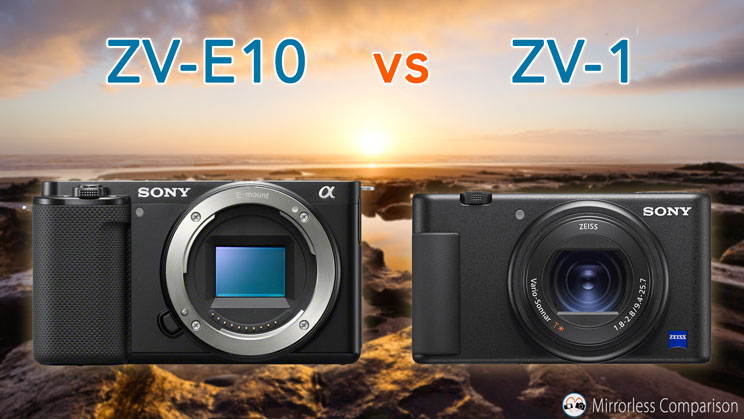
Ethics statement: the following is based on official specifications found on the Sony website. We were not asked to write anything about these products, nor were we provided with any sort of compensation. Within the article, there are affiliate links. If you buy something after clicking the link, we will receive a small commission. To know more about our ethics, you can visit our full disclosure page. Thank you!
1. Size
The ZV-1 is the smaller and lighter of the two. Being a compact camera with a collapsable lens, it is easier to put in a large pocket than the ZV-E10 which relies on interchangeable lenses (more on this in the next chapter).
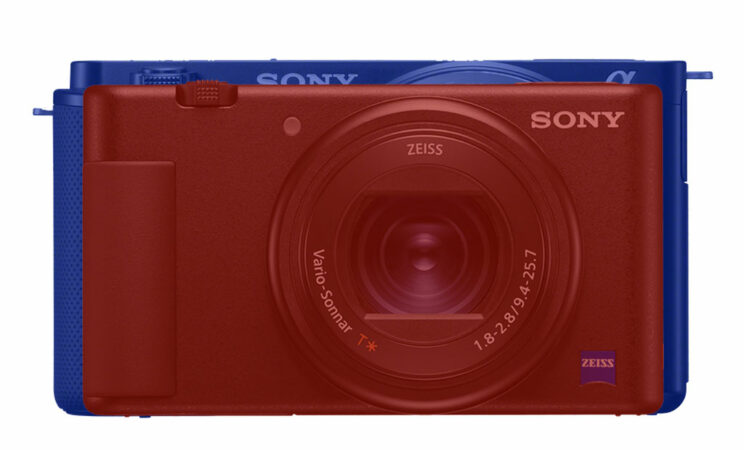
- ZV-1: 105.5 x 60 x 43.5mm, 294g
- ZV-E10: 115.2 x 64.2 x 44.8mm, 343g
The button layout is similar but the ZV-E10 has an extra exposure dial on top and a larger grip on the front.
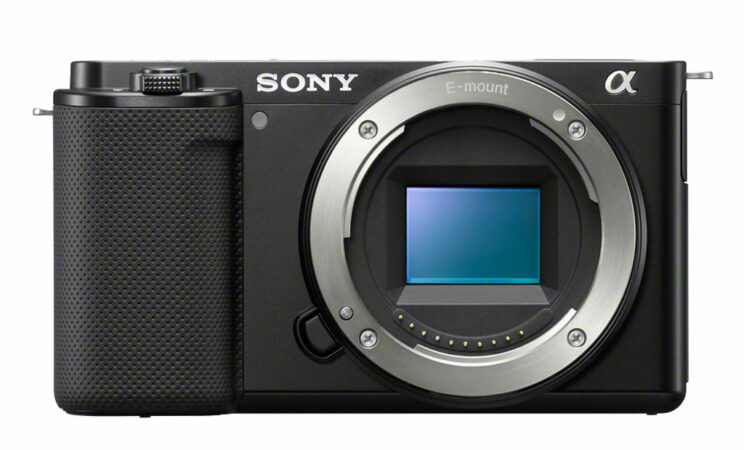
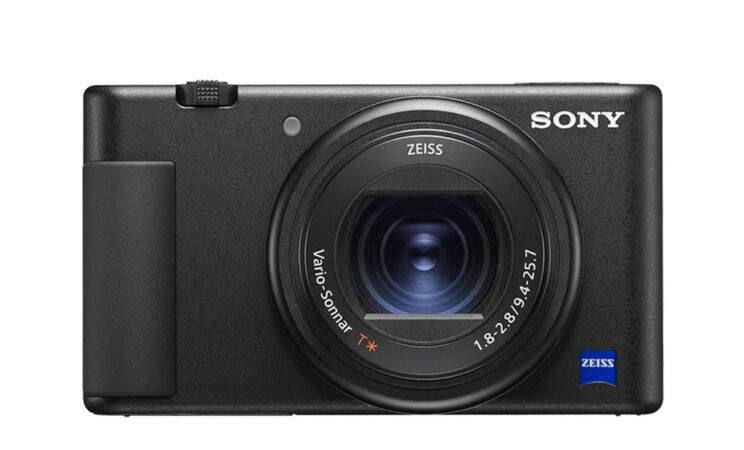

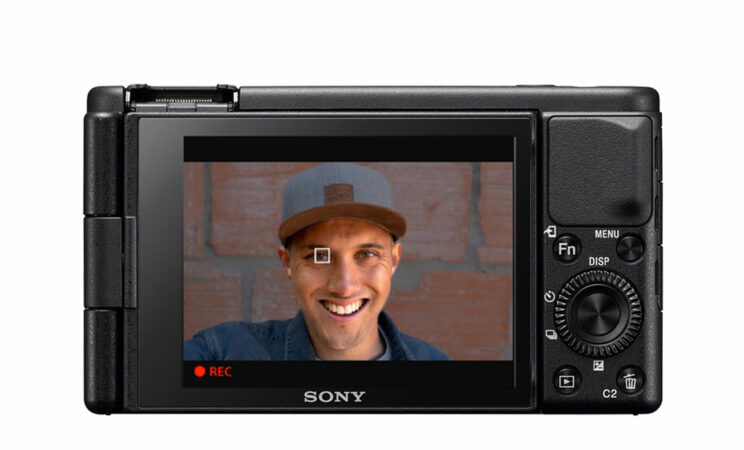
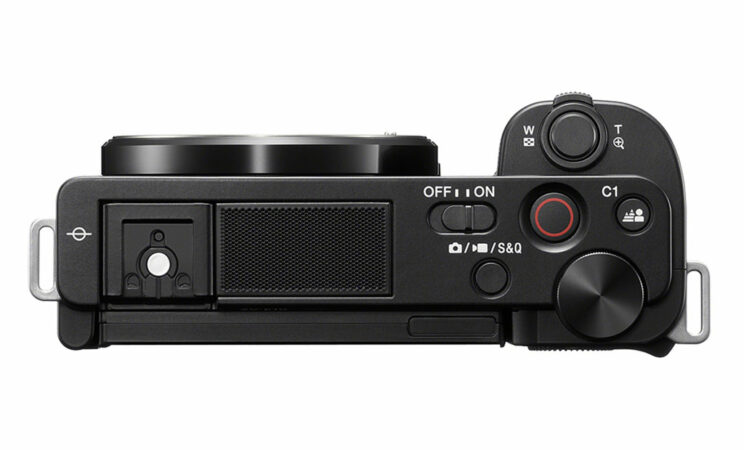
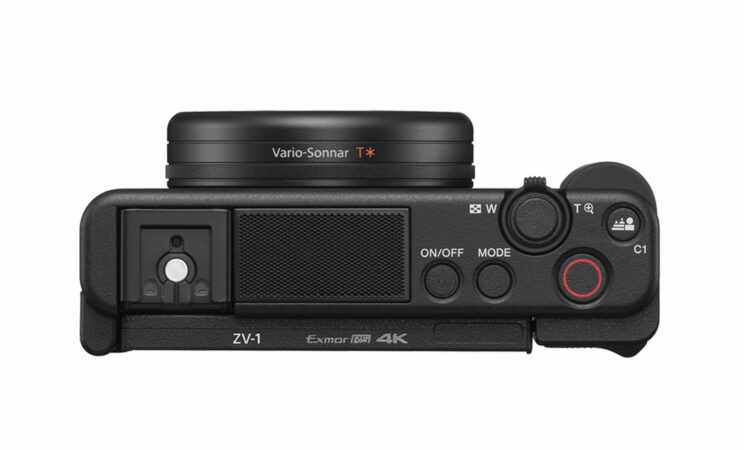
2. Lenses
This is one of the most important differences between the two products.
The ZV-E10 is an interchangeable-lens camera using the Sony E-mount. It gives you access to a large number of zoom and prime lenses, which include those designed by third party brands (Tamron, Sigma etc.) and E-mount lenses made for full frame sensors.
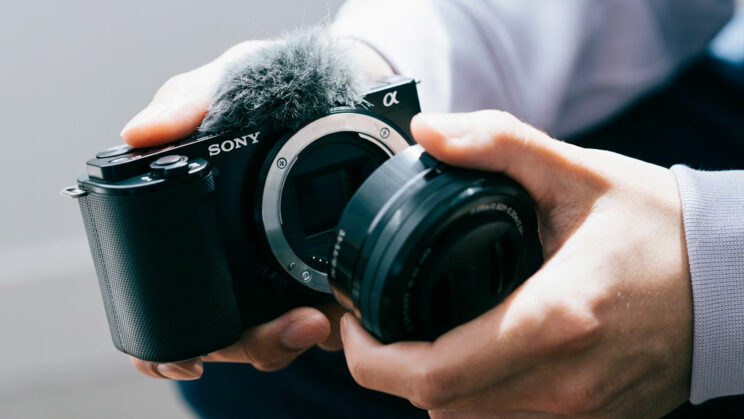
The camera can be purchased body only or bundled with the E 16-50mm F3.5-5.6 kit lens (24-75mm equivalent in full frame format) as a starting point.
The ZV-1 has a non-removable 2.7x optical zoom (9.4-25.7mm, or 24-70mm equivalent) with a bright aperture of F1.8 (wide) to F2.8 (tele). There are a few third-party wide angle lens adapters that literally stick in front of the lens (with the use of adhesive), which is certainly not a solution as robust as the E-mount lens system.
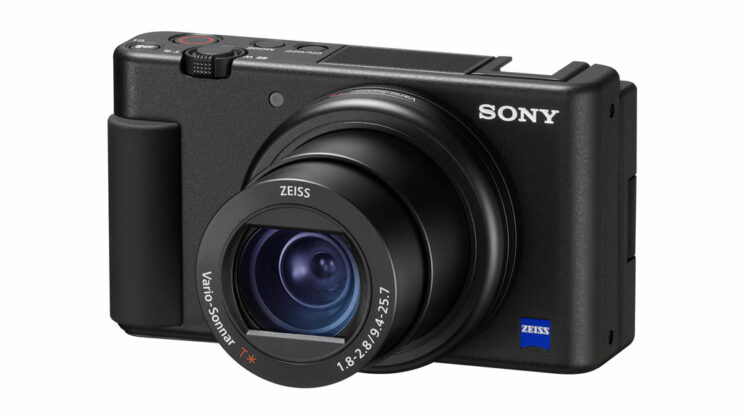
Both solutions have advantages and disadvantages. In the case of the ZV-1, it maintains its compact and “pocketable” design. The 24-70mm equivalent lens gives you the essential zoom range to work with.
With the ZV-E10, the possibility to use different lenses can add to your creativity and enrich your videos. For example you can use a super wide angle lens to capture the dramatic architectural lines of a building, or a fast portrait lens to take beautiful shots of a person.
Obviously, depending on the lens used, the size of the ZV-E10 set-up can grow considerably in comparison to the ZV-1. For example, the latter has a fast F1.8-2.8 zoom. If you want something similar for the E10 model, the Sony E 16-55mm F2.8 is significantly larger than the kit lens and will raise the cost quite a bit.
3. Sensor
The third very important difference between these two cameras is the sensor size.
The ZV-E10 uses an APS-C sensor with 24.2MP whereas the ZV-1 has a 1-inch sensor with 20.1MP. More than the difference in resolution, it is the sensor size that provides the ZV-E10 with an advantage here, with better dynamic range and low light performance for stills and video.
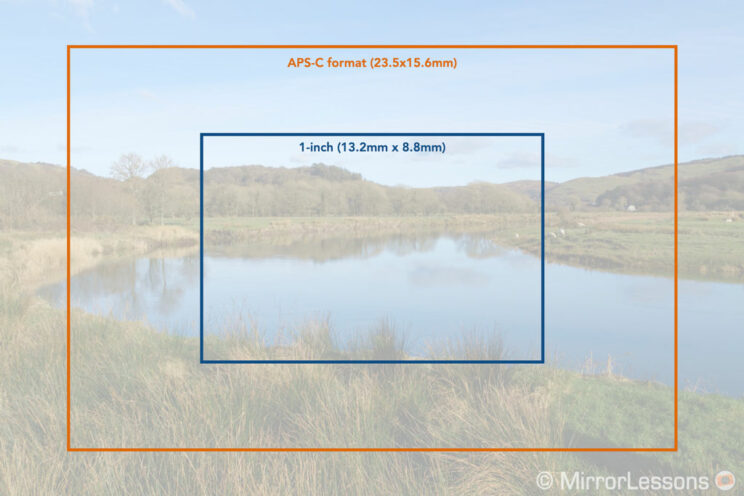
Speaking of low light, the ISO range is vaster on the APS-C camera:
- ZV-E10: 100 to 32,000 ISO (up to 102,400 with the extended values – stills only)
- ZV-E1: 100 to 12800 ISO (up to 25600 with the Multi-NR mode), or ISO 125 to 12800 for video
Another advantage of the larger APS-C sensor is the possibility to have more shallow depth of field (background blur) in your photos and videos.
With all the above said, the ZV-1 sensor has a few tricks of its own. It is a stacked sensor (Exmor RS) capable of a very fast readout speed. It also gives the camera stunning continuous shooting capabilities, super slow motion video and almost no rolling shutter when using the electronic shutter. (More on these features below.)
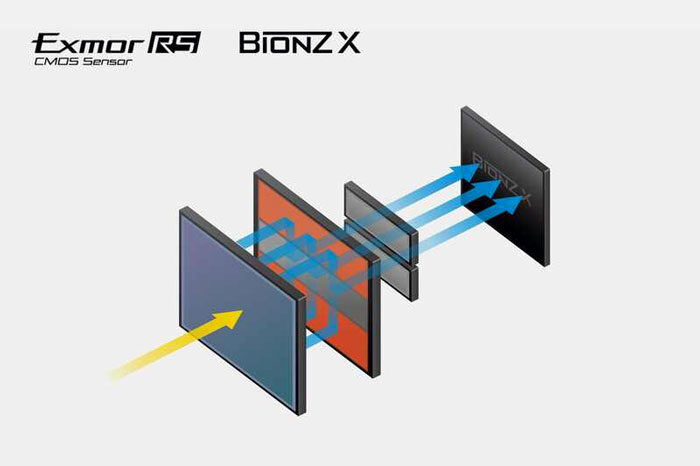
4. Built-in ND filter
Another advantage of the ZV-1 design is that it includes a built-in 2 stop ND filter which can be helpful to maintain a faster aperture outdoors in daylight when recording video (to maintain more background blur for example) or to use a slower shutter speed in still mode (to blur movements).
With the ZV-E10, you must rely on optional lens filters. You can find circular filters that attach in front of the lenses, or use a filter holder and square filters. You can even use multiple filters at once and you’ll find filters with a stronger effect than 2 stops.
Note that you can find online special adhesive-adapters for the ZV-1 that allow you to mount 52mm circular filters.
5. Autofocus
The two cameras share a lot of AF features including an advanced real-time tracking algorithm, Eye AF for humans/animals (still) and humans (video).

They both rely on a hybrid system with contrast and phase detection autofocus, but the number of points differ: the ZV-E10 has 425 points that cover approximately 84% of the sensor area, whereas the ZV-1 has 315 phase detection points and 425 contrast detection points.
6. Speed
The ZV-E10 can achieve a respectable 11fps in continuous shooting mode while maintaining continuous autofocus and exposure. The fastest shutter speed available is 1/4000s.
Thanks to its stacked sensor, the ZV-1 offers a burst speed up to 24fps (with RAW files, AE and AF tracking). The shutter speed goes up to 1/2000s with the mechanical shutter, or up to 1/32,000s with the electronic shutter.
7. Super Slow Motion
The ZV-1 sensor also enables the camera to record super slow motion video up to 1000fps (40x) in Full HD when the HFR mode is selected. Note that this feature is limited to a few seconds of recording time per clip, sound is not available and the quality is not as good as the normal movie mode, but it still remains a pretty special function that not a lot of cameras have.
In normal video mode, the ZV-1 can record Full HD up to 120fps, which is the same found on the ZV-E10.
Below you can watch a video I made a few years ago with the RX100 IV, the first camera from Sony with the Super Slow Motion capabilities, to give you an idea of the potential.
8. Audio
Both cameras feature a built-in directional 3-capsule microphone and a wind screen is also provided.
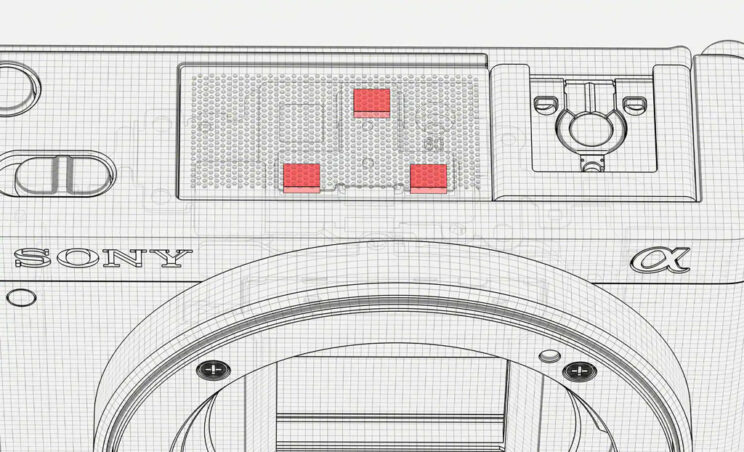
They both have a 3.5mm mic input, but only the ZV-E10 has a headphone output and compatibility with Sony’s digital audio recording via the Multi Interface shoe.
9. Battery life
Given the difference in size, the two cameras use different batteries.
The NP-FW50 has a rating of 440 shots or 80 minutes of video recording on the ZV-E10.
The NP-BX1 of the ZV-1 of 260 shots or 45 minutes of video.
As usual, these official ratings often increase in real life shooting.
10. Price
The ZV-E10 is on sale for $800 in the US, £770 in the UK or €850 in Europe with the kit lens, or $700 / £680 / €750 body only.
The ZV-1 costs $750, $700 or €720.
Bundles with extra accessories such as the Sony bluetooth grip are also available.
Note: prices as of late July 2021.
Conclusion
If you’re interested in V-Logging, the Sony ZV-1 and ZV-E10 are interesting propositions because they are tailored specifically for this usage. They rely on the brand’s excellent sensors and autofocus performance, with additional features that should make it easier to begin if you don’t have a lot of experience.
Choosing between the two models comes down to two main considerations: compactness versus better image quality, and a single lens versus multiple lenses.
The ZV-1 is smaller and the non-removable zoom lens gives you what you need to start. You’ll be able to carry the camera in the pocket of your jacket, or a small bag with essential accessories such as a microphone and grip. The smaller sensor may not offer the same image quality as the E10 model, but its processing speed gives you unique features like HFR mode (super slow motion).
The ZV-E10 is also compact (although a bit larger) but the lenses you use will most likely increase the overall size. From here the sky is the limit: you can stick to small prime lenses, or you can expand your kit to capture all sorts of footage and B-rolls. Of course, using multiple lenses will increase the total cost of your set-up, so the ZV-E10 can easily become a larger investment.
Reminder: the links below are affiliate links. If you decided to buy something after clicking the link, we will receive a small commission.
Check price of the Sony ZV-E10 on
Amazon UK | B&H Photo | eBay
Check price of the Sony ZV-1 on
Amazon | Amazon UK | B&H Photo | eBay
More about the ZV-E10:
Sony ZV-E10 vs A6400
More about the ZV-E1:
Panasonic G100 vs ZV-1
